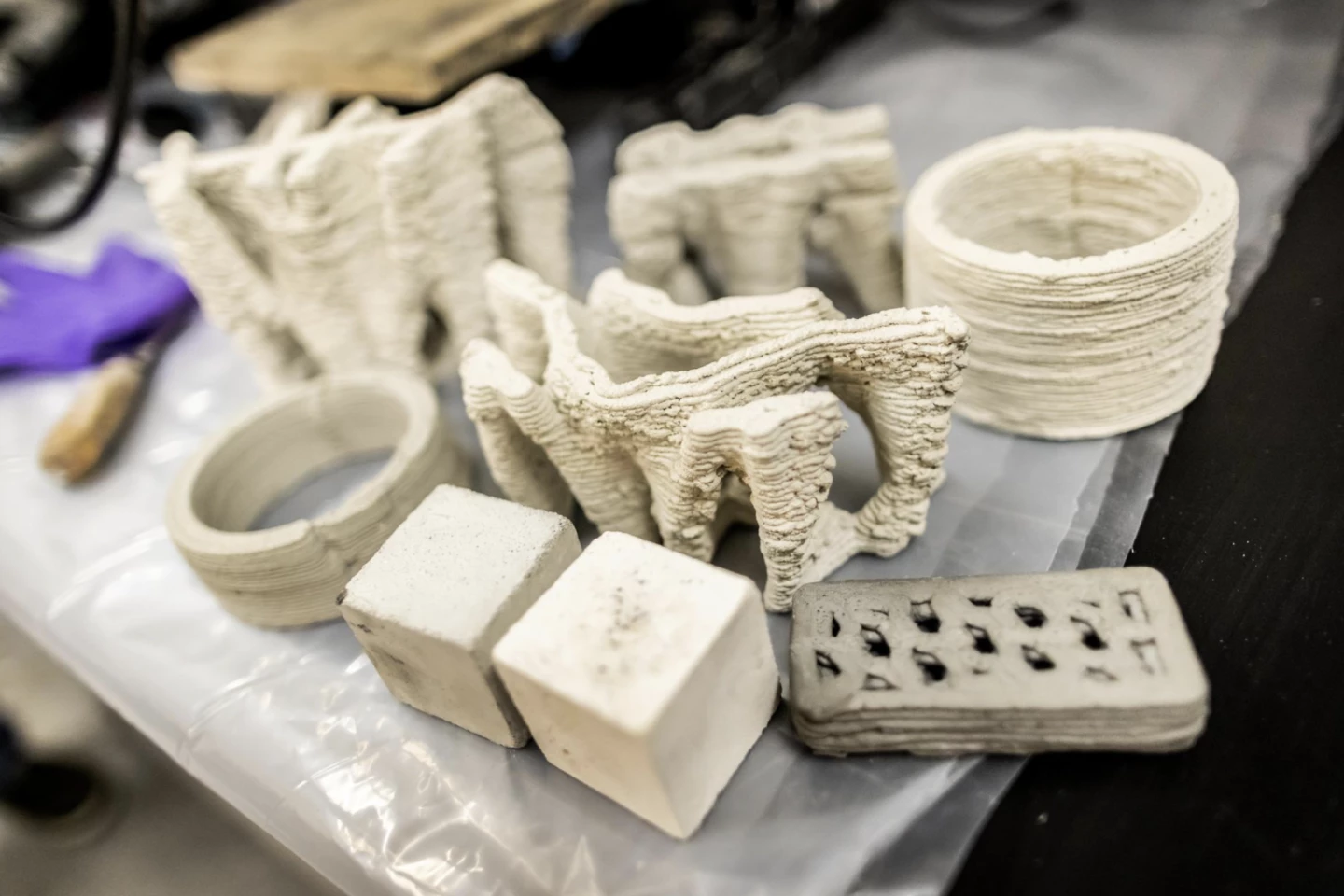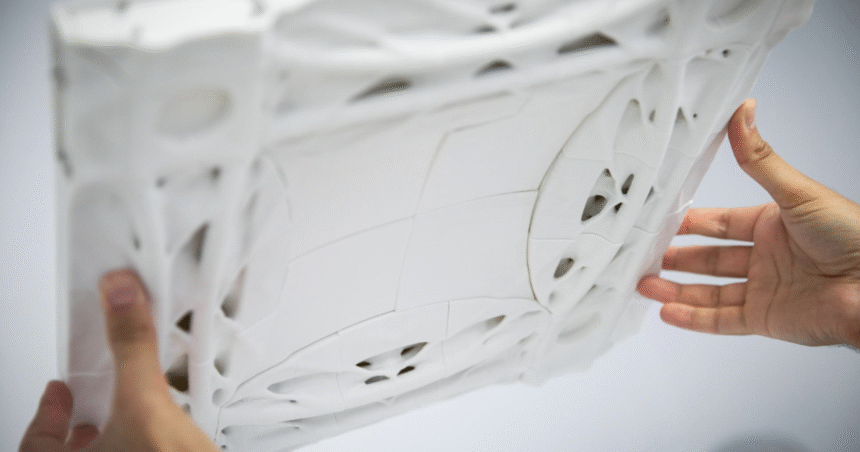Using intricate geometry found in nature and refined through aerospace and biomedical design, scientists have now 3D-printed these forms into concrete to boost strength and capture carbon – creating a scalable building material that benefits both people and planet.
A team of materials scientists, designers and engineers from the University of Pennsylvania (UPenn) has collaborated on a unique biomineral-infused concrete that draws from the fossilized architecture of microscopic algae to create an entirely new kind of concrete. It’s lightweight, structurally sound and can capture up to 142% more CO2 than traditional materials. It also uses less cement without compromising any compressive-strength metrics.
While sustainable, strong alternatives to standard concrete aren’t new – we’ve covered too many to mention – this material is particularly promising. Its “secret recipe” is built around diatomaceous earth (DE), a naturally occurring, powdery substance that’s made from the fossilized remains of diatoms – small, hard-shelled ancient algae. In engineering materials, DE is lightweight, has a high surface area and has a favorable porousness that’s ideal for absorbing CO2.
“Usually, if you increase the surface area or porosity, you lose strength,” says co-senior author Shu Yang, Chair of the Department of Materials Science at UPenn’s School of Engineering and Applied Science. “But here, it was the opposite; the structure became stronger over time.”

University of Pennsylvania
While concrete may be second in terms of materials we rely (water is the first), it accounts for a massive 8% of global greenhouse emissions. And current methods of attempting to make things “greener” are expensive, convoluted and limited in their CO2-capturing abilities.
During testing, the UPenn team found that its experimental design achieved “an additional 30% higher CO2 conversion” when the geometry was even further refined, and it did so while maintaining strength similar to traditional concrete.
“It was one of those rare moments where everything just worked better and looked nicer,” said Yang.
The researchers first engineered a “cementitious paste,” which was fluid enough to work with 3D-printing mechanics. This involved a mix of Portland cement, fine sand, and silica fume. A superplasticizer was also added to reduce water content while ensuring that the unique mix was still compatible for printing.
“Concrete isn’t like conventional printing materials,” said Kun-Hao Yu, a former postdoctoral researcher at UPenn. “It has to flow smoothly under pressure, stabilize quickly after extrusion, and then continuously strengthen as it cures.”
Robotic 3D printing was then used to create lattice-like structures – or triply periodic minimal surfaces (TPMS) – inspired by nature’s handiwork in forming bones and shells, These forms could provide both the space to capture carbon and provide the structural integrity of traditional concrete. The printed material was then left to cure (strengthen). Finally, a coat of calcium hydroxide was applied to boost its carbon capture properties.
The end result was a scalable, printable concrete that not only does the job structurally but also pulls carbon from the atmosphere, without complex processing or high cost.
“But it wasn’t just about aesthetics or reducing mass,” said co-senior author Masoud Akbarzadeh, associate professor of architecture at the Weitzman School of Design. “It was about unlocking a new structural logic. We could reduce material by almost 60%, and still carry the load, showing it’s possible to do so much more with so much less.”
As a zoologist (who isn’t particularly enamored by building materials), I am admittedly biased when it comes to what sets this concrete apart. While most of us who don’t work in the field of microscopic marine biology or micropaleontology may never come across diatoms in our lifetime, they’re pretty remarkable organisms. These small, single-celled algae are able to create intricate, beautiful shells made of silica (the same material in glass), called frustules. Each one is nanostructured with symmetry and microscopic pores. And each diatom assembles these incredible, intricate structures atom by atom, using proteins and enzymes to extract dissolved silica from the water they’re submerged in.
What’s more, we believe there are more than 100,000 diatom species, and together they produce 20-30% of the oxygen that keeps the planet alive. Which is more than all the rainforests on Earth manage. No shame to the rainforests and their heavy lifting, of course.
Drawing on diatoms for inspiration, the UPenn scientists may have come up with something that can benefit the planet almost as much as these tiny organisms. The team found that DE’s intricate internal pore network provided a robust pathway for carbon dioxide to diffuse into the structure, but also that the curing process allowed for calcium carbonate to form, boosting strength and CO2 uptake.
“We ran a lot of trials,” Yang said. “What surprised us most was that despite the high porosity that normally acts an impediment to stress, the material actually got stronger as it absorbed CO2.”
Once the researchers had perfected their design, it was sliced into layers for printing. The components were then tested against traditional concrete and found to use 68% less material while increasing surface-area-to-volume ratio by more than 500%. The TPMS slab had 90% of the compressive strength of concrete but 32% higher CO2 uptake per unit.
So, a TPMS cube, compared to a solid cube of traditional concrete, was able to absorb 146% more CO2, or 32% more CO2 per unit of cement (comparing gram to gram).
Now, the scientists are looking to scale up their novel material to form floors, facades, and load-bearing panels. They’re also investigating using DE with other compounds to see if the diatoms have even more to offer us.
“We want to push this idea further,” said Yang. “What if we could remove the cement altogether? Or use waste streams as the reactive component?”
“The moment we stopped thinking about concrete as static and started seeing it as dynamic – as something that reacts to its environment – we opened up a whole new world of possibilities,” she added.
The research was published in the journal Advanced Functional Materials.
Source: University of Pennsylvania








